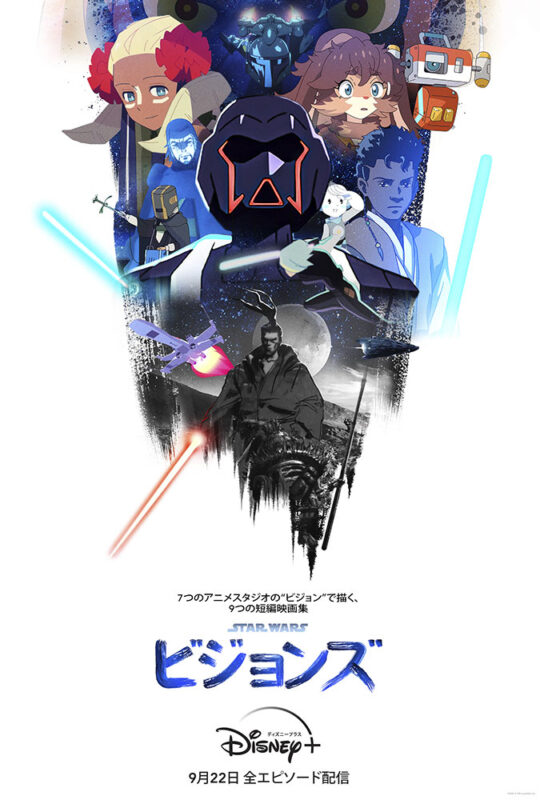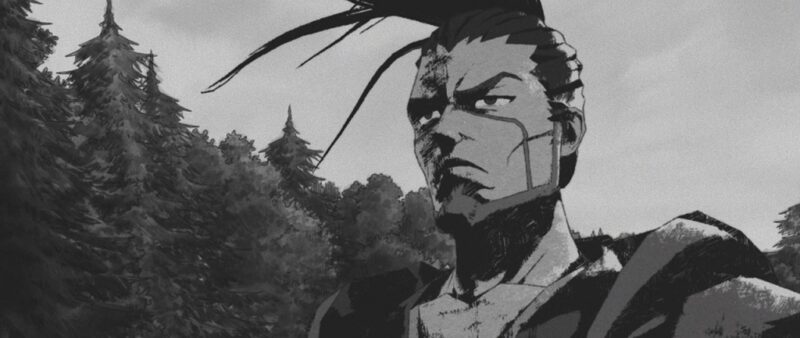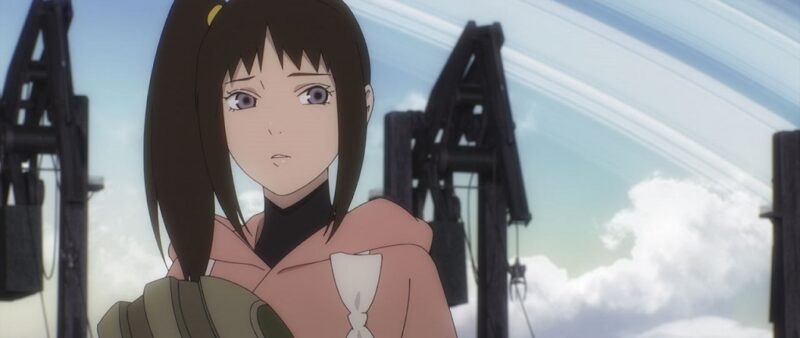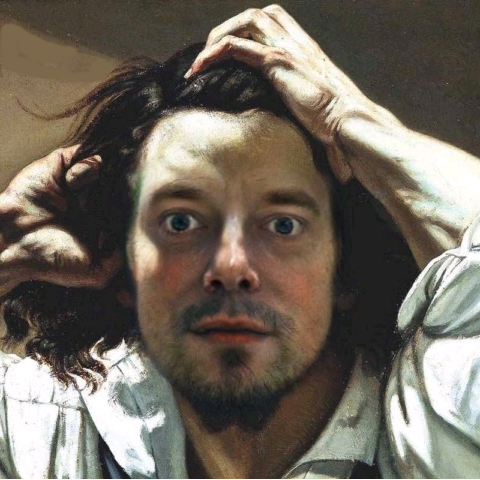
Among all the new things that Disney is doing with Star Wars to make it sustainable for the years and decades to come, now that the main series is over, there is one that is quite different from the rest, and that piqued my curiosity. I’m talking about Star Wars Visions.
I wouldn’t be surprised if you haven’t heard about it. I don’t really see much about it on social media compared to the other usual Star Wars things. Probably because it’s animation. Animation tends to get less coverage than live-action projects.
It’s a shame because it probably is the most original Star Wars project in years if not decades. But is it good? We’ll see. But before that, let’s answer the question:
What is Star Wars Visions?
As I’ve just mentioned it’s animation and more precisely, it’s Japanese animation, and it’s also Star Wars.
It’s basically a series of short animated stories (no episode is longer than 20 minutes) that are all independent from each other. They were all created by different teams and studios. All of these studios have one thing in common; they’re Japanese.
The choice may be odd to some, but I think it makes sense in many ways.
First, nowadays, anime is huge in the West. I could be wrong but kids seem to be into it even more than local productions. I’m not sure about other countries, but in France, where I’m from, anime has been popular with kids since the late 70s. These kids are now adults and have kids. And during these past forty years, their popularity has only increased. Manga joined the bandwagon in the 90s to the point that nowadays they constitute the mainstream pop culture in my country among the younger generations.
As an interesting side note, as you may know, I live in Japan (but I only really watch anime with my kids and I don’t read manga). And you can really divide French people living here into two generational groups. People older than 40 usually arrived in Japan and got interested in the country for various reasons, the first one being martial arts (karate and judo have been very popular in France for many decades now) and various elements of traditional culture (bonsai making, tea ceremony, etc.).
On the other hand, almost all French people who live in Japan and who are younger than 40 ended up here because of manga and animé.
Me? I arrived in Japan by total chance, so I’m not really your typical Frenchman in Japan.
End of the side note.

So, yes, anime is bigger than it’s ever been in many Western countries, but I think this is not the only reason for Star Wars Visions. The other reason may be Japan itself!
As you may imagine with its large population and GDP, Japan is a huge market. And Disney knows it.
It knows it very well because Disney is huge in Japan:
- Traditional Disney movies are as big in Japan as anywhere else. In terms of merchandising, I’m tempted to say that they’re even bigger than in the West (I don’t remember almost every kid in the West with Disney-themed clothes, bags, and so on).
- Pixar could be a bit bigger, but it’s still quite big. Toy Story, Cars, and more are mainstream among young kids.
- Marvel? I don’t know where to start with Marvel. Marvel is not huge, it’s beyond huge. For example, I teach university students, and the vast majority of them are obsessed with Marvel. Or should I say the MCU – actually, most of them don’t even know there’s this thing called Marvel Comics, which often results in amusing dumbfounded faces when I tell them that I read those growing up. In terms of merchandising, the number of items with just the Marvel logo and nothing else is quite impressive on campus and elsewhere. Is that even a thing in the West?
And then there is Star Wars.
Star Wars was huge… once…
People in their 40s and 50s loved it. However, it didn’t really follow suit with younger generations.
Once again, I’ll talk about merchandising as… well… it’s a big thing when talking about Disney, but I’m tempted to say, especially in Japan, where merchandising is probably more telling about the popularity of something than anything else. It is, after all, thanks to merchandising that Pokémon and Hello Kitty have become the two biggest franchises in the world. I mean, is Hello Kitty even a thing apart from being merchandising?
So, when The Force Awakens was released, Star Wars merchandising was literally everywhere. You could buy pretty much anything you could think of with a Star Wars logo or character on it. It felt like we were back in the early 80s. The offer was huge, but how big was the demand?
Well, when The Last Jedi was released, there still were quite a few merchandising items available, but clearly not as much.
For The Rise of Skywalker? Almost none at all.
I don’t have concrete numbers, but I have a strong feeling that the Star Wars revival coming from the new trilogy just failed to find a new audience in Japan. I’m not even sure that the Mandalorian is big here. I don’t remember a student ever talking to me about it. And they love telling me about Western pop culture when they’re into it. Kids? They just don’t know really Star Wars, or only as something their parents watch.
So, while I think that Star Wars Visions is an interesting artistic experiment from a Western perspective, I also definitely think that’s it’s an attempt from Disney to revive Star Wars’ popularity in Japan because it sure could get some help.
Will it work? No idea. But there is hope. Maybe Star Wars is just skipping a generation or two. Japanese young adults don’t care about Star Wars, but maybe the next generation will, as their parents are the ones who are fans in this country. We’ll see.
OK, but after this long introduction, what you want to know is probably this:
Is Star Wars Visions good? Is it worth watching?
Well… It depends.
Are you a Star Wars die-hard fan?
If you are, I know you’ll watch it no matter what. You probably already have. So the rest of this post is exactly not for you unless you want to see if you agree with me or not.
One big disclaimer though: if you’re obsessed with canon, you may have issues with some episodes. And on a personal note, you shouldn’t be obsessed with canon at all. Canon is for religions, not for works of fiction.
Are you into anime or animation in general? Or graphic design?
If yes, you should definitely watch it. I don’t know whether you’ll like it or not, but you’ll at least be interested in it.
Everyone else?
Well… It depends.
The interesting thing with such projects is also its main problem.
All episodes are so different and so diverse that you just can’t say “yes, it’s great” or “no, it sucks.”
Overall, I’d say that it’s really a mixed bag. Some episodes are really good, some are not so good. But really, the thing is that not every episode is for everyone. You may hate one episode that I loved and vice versa.
So, I’m going to review each episode in one paragraph or two, hoping it’ll help you pick episodes if you’re curious about the project but don’t want to take the time to watch the whole thing.
I do have one criticism that applies to most episodes, though. The stories are not exactly original. A lot of them are very archetypal tales that are simply applied to the Star Wars universe by Japanese people.
I kinda understand why. When you have less than 20 minutes to tell a full story with completely new characters, it’s extremely difficult to tell a very original and new story. But it was a bit frustrating at times.
There are nine episodes, let’s see what I have to say about each.
The Duel
Interesting first episode. I really love how it looks. It really doesn’t look like what you think of when you hear the word “anime” and are a casual watcher like I am. I liked the story overall, however, it really is just your usual ronin story with some Star Wars make-up applied to it.
Still, it’s interesting, as a lot of the inspiration for Star Wars comes from old Japanese movies, especially Kurozawa’s samurai movies.
Tatooine Rhapsody
Honestly, I didn’t like it. A bit too silly and too cliché for me. Also, the fact that it involves a lot of familiar characters (it’s the only episode that does) hurts it rather than helps it, I believe. With that being said, Star Wars is also for kids, and I’m pretty sure that this one is aimed at kids and that they will like it greatly, especially if they’re already Star Wars fans.
The Twins
I fell asleep watching it. I have no intention of trying to watch it again. Just not my cup of tea.
The Village Bride
Probably the best episode of the series. And the one that marries anime-style with the Star Wars universe the best. It kinda felt like an early Ghibli movie (it reminds me of Nausicaä and Princess Mononoke in a few ways) and it also felt like a Star Wars story at the same time. I recommend.
The Ninth Jedi
Was the story original? No, not really. It even was very predictable (they kinda all are). Did I enjoy it? Yes, greatly. Probably the most “Star Wars” of all of them.
Actually, it really feels like an introduction to something bigger. Maybe it is. I wouldn’t totally be surprised if one of the future and currently secret projects, including live-action movies, were related to that story somehow.
However, that feeling also means that it’s the one story that feels the less “experimental” and the more “regular Star Wars project” of all. Not exactly a criticism, but a feeling that maybe it doesn’t belong to this project.
T0-B1
A very cute story, that feels like an homage to both Star Wars and Tezuka. Cute, really is the main keyword here. Mostly for kids. Or for people who like cute things.
The Elder
Once again, nothing too out of the ordinary in terms of plot, but a very compelling story nonetheless. I think it’s probably the one that has the best balance of that mix between Star Wars and Japaneseness that a lot of the stories have.
Lop & Ochō
I liked it. The main character will probably become a fan favorite (and be revisited in the future?). Another story that mixes Japan and Star Wars in a very interesting way, as the setting is basically the Galactic Empire colonizing a planet that is pretty much indistinguishable from Edo’s Japan.
Should we see this as a metaphor for the Meiji Era, the time period in the late 19th Century when Japan had to open itself to the world and went from being a medieval country to a modern one in half a Century? Maybe.
The story and characters were very rich and quite fleshed out for such a short story (they’re also quite archetypal, that helps), but unfortunately, the pace was a bit too fast for the story it was trying to tell. A much longer format would have benefited it.
Akakiri
Hmmm… I’m not too sure what to think of it. I’m not too crazy about the visual aspect of the story. And while the story is a clear homage to The Hidden Fortress, one of the main inspirations for Star Wars, it doesn’t really feel like a Star Wars story at all. It’s also a little bit of my problem with the first story, The Duel, but here it’s even more pronounced. The only thing that allows it to be “Star Wars” is that the main protagonist and the main antagonist have lightsabers, and that’s pretty much it. Everything else is medieval Japan with a few aliens sprinkled here and there.

Conclusion
So as you see, there are many kinds of stories for all tastes, even if they have some common traits.
I feel that some of them could be some sort of “pilot episodes” for much bigger projects. Will it happen? Well, if the point of this experiment is to bring in a new audience from Japan, maybe it will.
We’ll see.
Image source: Star Wars official site.
Discover more from liminal web
Subscribe to get the latest posts sent to your email.

